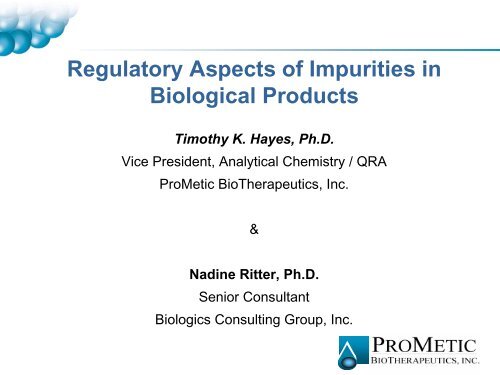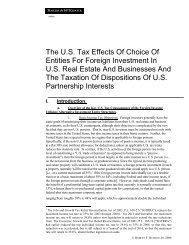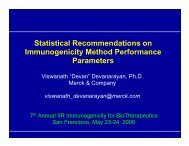Regulatory Aspects of Impurities in Biological Products - IIR
Regulatory Aspects of Impurities in Biological Products - IIR
Regulatory Aspects of Impurities in Biological Products - IIR
Create successful ePaper yourself
Turn your PDF publications into a flip-book with our unique Google optimized e-Paper software.
<strong>Regulatory</strong> <strong>Aspects</strong> <strong>of</strong> <strong>Impurities</strong> <strong>in</strong><br />
<strong>Biological</strong> <strong>Products</strong><br />
Timothy K. Hayes, Ph.D.<br />
Vice President, Analytical Chemistry / QRA<br />
ProMetic BioTherapeutics, Inc.<br />
&<br />
Nad<strong>in</strong>e Ritter, Ph.D.<br />
Senior Consultant<br />
Biologics Consult<strong>in</strong>g Group, Inc.
Where is it written?<br />
Presentation Outl<strong>in</strong>e<br />
Classification <strong>of</strong> impurities <strong>in</strong> biological products<br />
Focus on ICH Q6B<br />
Example Approach to support<strong>in</strong>g Specifications<br />
for Process Related <strong>Impurities</strong>
Where It Is Written<br />
FDA has no specific guidance<br />
ICH Web Site:<br />
http://www.ich.org/cache/compo/276-254-1.html<br />
ICH Q3 Series on <strong>Impurities</strong> <strong>in</strong> Pharmaceutical <strong>Products</strong><br />
excludes Biotechnology / <strong>Biological</strong> <strong>Products</strong> from scope<br />
ICH Q6B – Specifications; Test Procedures; and Acceptance<br />
Criteria for Biotechnology / <strong>Biological</strong> <strong>Products</strong><br />
ICH Q5C – Quality <strong>of</strong> Biotechnology <strong>Products</strong>: Stability Test<strong>in</strong>g<br />
<strong>of</strong> Biotechnology / <strong>Biological</strong> <strong>Products</strong><br />
ICH Q5D – Derivation and Characterization <strong>of</strong> Cell Substrates<br />
Used for Production <strong>of</strong> Biotechnology / <strong>Biological</strong> <strong>Products</strong><br />
ICH Q5E – Comparability <strong>of</strong> Biotechnology / <strong>Biological</strong> <strong>Products</strong><br />
Subject to Changes <strong>in</strong> Their Manufactur<strong>in</strong>g Processes
CMC Strategy Forum July 2004<br />
Gold Sheet Vol. 38 No. 9 September 2004<br />
F-D-C Reports<br />
http://www.thegoldsheet.com/FDC/monthly/gold/PrevMenu.htm<br />
CMC Strategy Forum White Papers (BioProcess<br />
International) Def<strong>in</strong><strong>in</strong>g Your Product Pr<strong>of</strong>ile and Keep<strong>in</strong>g<br />
Control Over It<br />
http://www.bioprocess<strong>in</strong>tl.com/default.asp?page=cmc<br />
Part 1: Simmerman and Donnelly (June 2005) Process Related<br />
<strong>Impurities</strong><br />
Part 2: Champion, Madden, Dougherty, and Shacter (Sept 2005)<br />
Challenges <strong>of</strong> Monitor<strong>in</strong>g Host Cell Prote<strong>in</strong> <strong>Impurities</strong><br />
Part 3: Boerner and Clouse (Oct 2005) Product Related<br />
<strong>Impurities</strong><br />
Part 4: Broerson and Phillips (Nov 2005) Product Related<br />
<strong>Impurities</strong>: Tackl<strong>in</strong>g Aggregates
ICH Q6B Overview<br />
Specifications; Test Procedures; and Acceptance Criteria for<br />
Biotechnology / <strong>Biological</strong> <strong>Products</strong><br />
August 1999<br />
Outil<strong>in</strong>es the nature and extent <strong>of</strong> elements needed to set<br />
mean<strong>in</strong>gful specifications for:<br />
Test Methods<br />
Process<br />
Product<br />
Specifications are the sponsor’s contract with regulatory authorities<br />
Q6B def<strong>in</strong>es the key CMC <strong>in</strong>formation that is required to support the<br />
design <strong>of</strong> specifications throughout the entire product development<br />
cycle<br />
Acceptance Criteria and Specifications are based on:<br />
The capabilities <strong>of</strong> the test methods<br />
The capabilities <strong>of</strong> the process that produces the product<br />
The nature <strong>of</strong> the lots <strong>of</strong> product produced for phase I-II-III cl<strong>in</strong>ical trials<br />
The stability <strong>of</strong> the bulk substance and f<strong>in</strong>al biological product
Q6B Recognizes the Heterogeniety <strong>of</strong><br />
<strong>Biological</strong> <strong>Products</strong>
Q6B Def<strong>in</strong>es Product-Related Substances
Q6B Def<strong>in</strong>es Process-Related <strong>Impurities</strong><br />
<strong>Impurities</strong> derived from the process<br />
Host cell prote<strong>in</strong>s or source derived prote<strong>in</strong>s<br />
Host cell nucleic acids<br />
Cell culture components<br />
Antibiotics, chemical <strong>in</strong>duction reagents (methyltrexate)<br />
Medium components like transferr<strong>in</strong> or <strong>in</strong>sul<strong>in</strong><br />
Down-stream process related impurities<br />
Organic solvents and detergents (TNBP, tween, triton)<br />
Column leachables (prote<strong>in</strong> A, antibodies, small ligands,<br />
metals)<br />
Enzymes (proteases)<br />
Denaturants (guanid<strong>in</strong>e HCl)
Q6B Def<strong>in</strong>es Product-Related <strong>Impurities</strong><br />
Variants <strong>of</strong> the product that arise dur<strong>in</strong>g<br />
manufactur<strong>in</strong>g and/or storage that do not have<br />
propertie comparable to those <strong>of</strong> the desired<br />
product.<br />
Product precursors<br />
Product degradants<br />
Fragments<br />
Dimers, trimers, oligomers<br />
Oxidation, deamidation, deglycosylation, etc.
Q6B Def<strong>in</strong>es Contam<strong>in</strong>ants<br />
Adventitious Agents<br />
Mycoplasma<br />
Bacteria<br />
Viruses<br />
Prions*<br />
Entotox<strong>in</strong>s and pyrogens<br />
Inactivation and/or clearance for safety
Q6B Suggests a Specifications Design Record<br />
for <strong>Impurities</strong><br />
Identify the impurity<br />
Measure the impurity with suitable test methods<br />
Assess safety risks <strong>of</strong> the impurity<br />
Design the process to be capable <strong>of</strong> clear<strong>in</strong>g or at least<br />
reduc<strong>in</strong>g impurities <strong>of</strong> concern<br />
Characterize / validate the process to understand and<br />
demonstrate critical process parameters that yield<br />
impurity control for the product<br />
Submit impurity specifications that reflect an<br />
understand<strong>in</strong>g <strong>of</strong> impurity risk and process capability to<br />
produce a product with safe impurity levels
Specifications vs Process Validation<br />
CMC Strategy Forum July 2004<br />
Consensus <strong>of</strong> attendees: validation <strong>of</strong> a<br />
process to consistently remove or control<br />
impurities could reduce the number <strong>of</strong><br />
specifications for a biotech product.<br />
Process validation generally is not substantial<br />
enough to reduce impurity specifications until<br />
after phase III trials.
Process-Related Impurity Decision Tree and<br />
Specifications Inspired by Q6B<br />
Heather Simmerman <strong>of</strong> Amgen first suggested a<br />
decision tree format at the CMC Strategy Forum,<br />
July 2004<br />
Basis <strong>in</strong> Q6B<br />
Identify Impurity<br />
Develop a suitable assay to measure the impurity<br />
Assess the safety risk <strong>of</strong> the impurity<br />
Understand the capability <strong>of</strong> the process to control the<br />
impurity<br />
Set mean<strong>in</strong>gful specifications from the understand<strong>in</strong>g<br />
<strong>of</strong> critical process parameters that produce a product<br />
with appropriate impurity characteristics
Question 1<br />
Is the nature and source <strong>of</strong> the impurity known?<br />
Have sensitive and broad detection methods been<br />
used to discover impurities?<br />
Yes- go to question 2<br />
No<br />
Demonstrate your impurity screen<strong>in</strong>g methods are not<br />
<strong>in</strong>sensitive and/or have narrow vision<br />
Categorize the nature and source <strong>of</strong> the impurity<br />
Process-Related, Product-Related, Contam<strong>in</strong>ant<br />
Inorganic, organic, biochemical, microbiological, physical<br />
Cell substrate, cell culture, down-stream, adventitious
Question 2<br />
Can you measure the amount <strong>of</strong> the impurity<br />
with appropriate sensitivity, accuracy and<br />
precision?<br />
Yes – go to Question 3<br />
No<br />
Develop an appropriate method and monitor the<br />
impurity at appropriate process po<strong>in</strong>ts
Question 3<br />
Is the impurity generally considered safe by the<br />
<strong>in</strong>dustry and/or a qualified toxicologist familiar<br />
with the area? Is the impurity with<strong>in</strong> published<br />
limits consider<strong>in</strong>g the dose and route <strong>of</strong><br />
adm<strong>in</strong>istration?<br />
Yes – No acceptance criteria is necessary,<br />
provided that product quality or stability is not<br />
compromised (Move to question 7)<br />
No – move to Question 4
Is the impurity qualified by toxicology,<br />
pharmacology, and safety data?<br />
Yes – Question 5<br />
Question 4<br />
No – Perform studies to correlate, if possible, the<br />
level <strong>of</strong> impurity with<br />
Toxicological<br />
Pharmacological effects<br />
Consider<br />
Route <strong>of</strong> adm<strong>in</strong>istration<br />
Dose and regimen<br />
Duration<br />
Target population
Question 5<br />
Is the level <strong>of</strong> the impurity throughout the<br />
process known?<br />
Yes – Question 6<br />
No<br />
Measure the impurity at appropriate process po<strong>in</strong>ts<br />
Determ<strong>in</strong>e the reproducibility at the appropriate<br />
process po<strong>in</strong>ts<br />
Is the stability <strong>of</strong> the impurity impacted by different<br />
process variables? Adjust approach based on data.
Question 6<br />
Is the level <strong>of</strong> the impurity below the qualified<br />
safety level?<br />
Yes – Question 7<br />
No – Improve the process to reduce the impurity<br />
to acceptable levels
Question 7<br />
Would the impurity pose a significant safety risk if<br />
present or does it affect the stability <strong>of</strong> the drug<br />
substance?<br />
Yes<br />
Set acceptance criteria for impurity <strong>in</strong> drug substance<br />
Base on pre-cl<strong>in</strong>ical and cl<strong>in</strong>ical safety studies and the process<br />
capability to remove<br />
Consider regulatory compendial requirements and guidance<br />
documents<br />
Establish mass balance for toxic additives<br />
No<br />
Consider sett<strong>in</strong>g <strong>in</strong>-process acceptance criteria or limits to<br />
ensure control <strong>of</strong> process removal<br />
If the impurity co-purifies, b<strong>in</strong>ds-to, or modifies the drug<br />
substance, these controls are more important
Process Consistency<br />
Major components <strong>of</strong> the impurity pr<strong>of</strong>ile are<br />
important considerations<br />
Process-related impurities<br />
Product-related impurities<br />
Product-related substances<br />
Comparability studies also rely heavily on<br />
comparable impurity pr<strong>of</strong>iles
Q6B Suggests a Specifications Design Record<br />
for <strong>Impurities</strong><br />
Identify the impurity<br />
Measure the impurity with suitable test methods<br />
Assess safety risks <strong>of</strong> the impurity<br />
Design the process to be capable <strong>of</strong> clear<strong>in</strong>g or at least<br />
reduc<strong>in</strong>g impurities <strong>of</strong> concern<br />
Characterize / validate the process to understand and<br />
demonstrate critical process parameters that yield<br />
impurity control for the product<br />
Submit impurity specifications that reflect an<br />
understand<strong>in</strong>g <strong>of</strong> impurity risk and process capability to<br />
produce a product with safe impurity levels
















